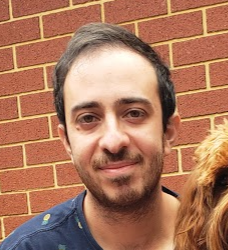Note
Click here to download the full example code
Gaussian transformation¶
Author: Josh Izaac — Posted: 11 October 2019. Last updated: 16 October 2020.
This tutorial demonstrates the basic working principles of PennyLane for continuous-variable (CV) photonic devices. For more details about photonic quantum computing, the Strawberry Fields documentation is a great starting point.
The quantum circuit¶
For this basic tutorial, we will consider a special subset of CV operations: the Gaussian transformations. We work with the following simple Gaussian circuit:
What is this circuit doing?
We begin with one wire (qumode) in the vacuum state. Note that we use the same notation \(|0\rangle\) for the initial state as the previous qubit tutorial. In a photonic CV system, this state is the vacuum state, i.e., the state with no photons in the wire.
We displace the qumode. The displacement gate linearly shifts the state of the qumode in phase space. The vacuum state is centered at the origin in phase space, while the displaced state will be centered at the point \(\alpha\).
We rotate the qumode. This is another linear transformation in phase space, albeit a rotation (by angle \(\phi\)) instead of a displacement.
Finally, we measure the mean photon number \(\langle\hat{n}\rangle = \langle\hat{a}^\dagger \hat{a}\rangle\). This quantity, which tells us the average amount of photons in the final state, is proportional to the energy of the photonic system.
The aim of this tutorial is to optimize the circuit parameters \((\alpha, \phi)\) such that the mean photon number is equal to one. The rotation gate is actually a passive transformation, meaning that it does not change the energy of the system. The displacement gate is an active transformation, which modifies the energy of the photonic system.
Constructing the QNode¶
As before, we import PennyLane, as well as the wrapped version of NumPy provided by PennyLane:
import pennylane as qml
from pennylane import numpy as np
Next, we instantiate a device which will be used to evaluate the circuit.
Because our circuit contains only Gaussian operations, we can make use of the
built-in default.gaussian device.
dev_gaussian = qml.device("default.gaussian", wires=1)
After initializing the device, we can construct our quantum node. As before, we use the
qnode() to convert our quantum function
(encoded by the circuit above) into a quantum node running on the default.gaussian
device.
@qml.qnode(dev_gaussian)
def mean_photon_gaussian(mag_alpha, phase_alpha, phi):
qml.Displacement(mag_alpha, phase_alpha, wires=0)
qml.Rotation(phi, wires=0)
return qml.expval(qml.NumberOperator(0))
Notice that we have broken up the complex number \(\alpha\) into two real
numbers mag_alpha and phase_alpha, which form a polar representation of
\(\alpha\). This is so that the notion of a gradient is clear and well-defined.
Optimization¶
As in the qubit rotation tutorial, let’s now use one of the built-in PennyLane optimizers in order to optimize the quantum circuit towards the desired output. We want the mean photon number to be exactly one, so we will use a squared-difference cost function:
def cost(params):
return (mean_photon_gaussian(params[0], params[1], params[2]) - 1.0) ** 2
At the beginning of the optimization, we choose arbitrary small initial parameters:
init_params = np.array([0.015, 0.02, 0.005], requires_grad=True)
print(cost(init_params))
Out:
0.9995500506249999
When the gate parameters are near to zero, the gates are close to the identity transformation, which leaves the initial state largely unchanged. Since the initial state contains no photons, the mean photon number of the circuit output is approximately zero, and the cost is close to one.
Note
We avoided initial parameters which are exactly zero because that corresponds to a critical point with zero gradient.
Now, let’s use the GradientDescentOptimizer, and update the circuit
parameters over 100 optimization steps.
# initialise the optimizer
opt = qml.GradientDescentOptimizer(stepsize=0.1)
# set the number of steps
steps = 20
# set the initial parameter values
params = init_params
for i in range(steps):
# update the circuit parameters
params = opt.step(cost, params)
print("Cost after step {:5d}: {:8f}".format(i + 1, cost(params)))
print("Optimized mag_alpha:{:8f}".format(params[0]))
print("Optimized phase_alpha:{:8f}".format(params[1]))
print("Optimized phi:{:8f}".format(params[2]))
Out:
Cost after step 1: 0.999118
Cost after step 2: 0.998273
Cost after step 3: 0.996618
Cost after step 4: 0.993382
Cost after step 5: 0.987074
Cost after step 6: 0.974837
Cost after step 7: 0.951332
Cost after step 8: 0.907043
Cost after step 9: 0.826649
Cost after step 10: 0.690812
Cost after step 11: 0.490303
Cost after step 12: 0.258845
Cost after step 13: 0.083224
Cost after step 14: 0.013179
Cost after step 15: 0.001001
Cost after step 16: 0.000049
Cost after step 17: 0.000002
Cost after step 18: 0.000000
Cost after step 19: 0.000000
Cost after step 20: 0.000000
Optimized mag_alpha:0.999994
Optimized phase_alpha:0.020000
Optimized phi:0.005000
The optimization converges after about 20 steps to a cost function value of zero.
We observe that the two angular parameters phase_alpha and phi
do not change during the optimization. Only the magnitude of the complex
displacement \(|\alpha|\) affects the mean photon number of the circuit.
Continue on to the next tutorial, Plugins and hybrid computation, to learn how to utilize the extensive plugin ecosystem of PennyLane, build continuous-variable (CV) quantum nodes, and to see an example of a hybrid qubit-CV-classical computation using PennyLane.
